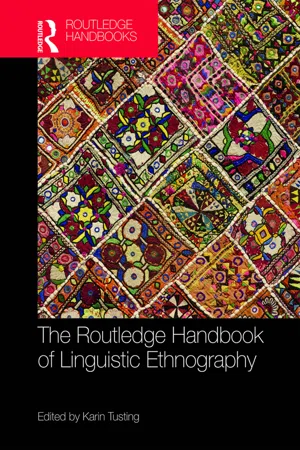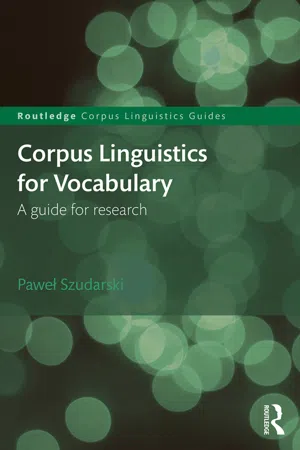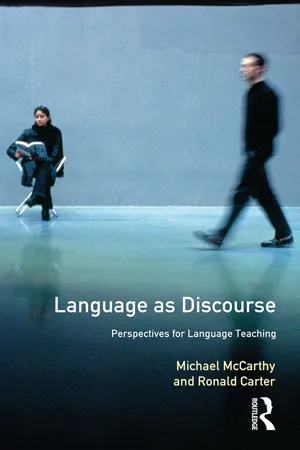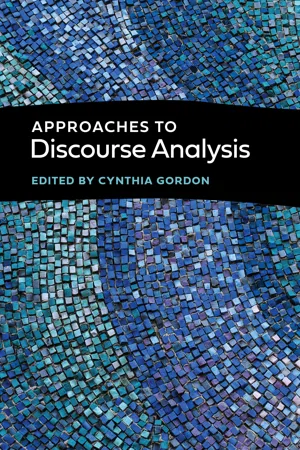Discourse
Discourse refers to the use of language in communication, encompassing both spoken and written forms. It involves the study of how language is used to convey meaning, shape social interactions, and construct knowledge. Discourse analysis examines the structure, patterns, and functions of language in various contexts, shedding light on the underlying cultural, social, and cognitive processes at play.
7 Key excerpts on "Discourse"
- eBook - ePub
- Karin Tusting, Karin Tusting(Authors)
- 2019(Publication Date)
- Routledge(Publisher)
...One can note, on the one hand, a continuation of more linguistic uses of the term, in which Discourse is viewed as the layer of meaning which is tied more directly to situations of language use. The focus here is often on large collections of verbal material of a particular situation or activity type and the use of quantitative methods and techniques of corpus linguistics (Biber et al., 2007). Specific Discourse-related themes are selected for closer attention (e.g. Warren, 2006 on aspects of naturalness in informal conversational language use). On the other hand, recent decades have witnessed the formulation of a broad project of Discourse studies which more holistically views language use, often in combination with other forms of semiotic behaviour, from the angle of ‘social practice’. Much Discourse research thus simultaneously attends to aspects of text and talk, processes of interpretation and cognition, and social-actional dimensions of communicative behaviour as well as its functioning at the level of ideological reproduction and socio-cultural transformation. Especially in the latter tradition, Discourse analysis has often (if not mostly) stood in an applied relationship to the social world, with Discourse research oriented to the identification of recommendations for practice (here echoing Brumfit’s definition of applied linguistics as engaged with real-world problems and issues in which language plays a central role (Brumfit, 2001))...
- eBook - ePub
Corpus Linguistics for Vocabulary
A Guide for Research
- Paweł Szudarski(Author)
- 2017(Publication Date)
- Routledge(Publisher)
...p.160 Chapter 9 Discourse, pragmatics and vocabulary 9.1 What is Discourse and Discourse analysis? Discourse is a notoriously difficult term to define but in general “it refers to units of language above the level of the sentence” (McEnery and Hardie 2012: 132). In a detailed definition, Thornbury (2010) enumerates three main senses of the term: Discourse as connected text, Discourse as language in use and Discourse as social practices. Similarly, Gee (1999) distinguishes between Discourse (with a little d) and Discourse (with a capital D). While the former is concerned with language in use in specific contexts, the latter involves not only linguistic practices but also systems of knowledge, beliefs and other elements of social life. This distinction is also reflected in Groom, Charles and John’s (2015) discussion of Discourse-oriented approaches. The authors posit that there are two basic types of Discourse analysis: the first one concentrates on the structure of different kinds of interactions and the other is the study of conventionalized meanings, values and ideologies held by specific social groups. What transpires from the above definitions is that Discourse analysis is an umbrella term and it encompasses a set of mainly qualitative methods and practices aimed at exploring specific examples of language in use and studying how meaning emerges in the process of interaction (Biber, Connor and Upton 2007). Corpus linguistics, in turn, tends to be perceived as a quantitative methodology, which relies on frequency data and statistical procedures and seeks to reveal typical patterns of natural language use. It becomes evident then that there are inherent differences between these two approaches to the study of language...
- eBook - ePub
Researching Discourse
A Student Guide
- Christopher Hart, Christopher Hart(Authors)
- 2020(Publication Date)
- Routledge(Publisher)
...I shall say a bit more about this later. For now, however, let us conclude this section with some definitions of ‘Discourse’ sourced from the academic literature. Discourse analysis examines how stretches of language, considered in their full textual, social, and psychological context, become meaningful and unified for their users (Cook, 1989: ix). People in a variety of academic departments and disciplines use the term ‘Discourse analysis’ for what they do, how they do it, or both … Discourse analysts pose many different questions and propose many different sorts of answers (Johnstone, 2002: 1). So abundant are definitions of Discourse that many linguistics books on the subject now open with a survey of definitions … They all, however, fall into … three main categories … (1) anything beyond the sentence, (2) language use, and (3) a broader range of social practice that includes non-linguistic and nonspecific instances of language (Tannen, Hamilton, and Schiffrin, 2015: 1). As you read the chapters in this book, and in your wider reading, try to identify where the author(s) position themselves in relation to these definitions, and consider too where you would position yourself as a budding Discourse analyst. Discourse data How many words do you think you have spoken this week? How many have you heard spoken? (And how do you define a word – do ‘um’/‘erm’ count?) How many words have you read this week? (Including those you may have read inadvertently, like labels and signs you encounter in passing.) How much have you written? (Including online/on your mobile phone.) Now imagine multiplying all the linguistic communication you have been involved in during this one week by all the weeks of your life so far, and then by all the people alive now, and then by all the human beings who have. ever left any records – written, recorded as audio signals, or in any digital form...
- eBook - ePub
Language as Discourse
Perspectives for Language Teaching
- Michael Mccarthy, Ronald Carter(Authors)
- 2014(Publication Date)
- Routledge(Publisher)
...Increasingly, literary texts are becoming a subject for Discourse analysis; indeed, the term Discourse stylistics now refers to the practice of using Discourse analysis in the study of literary texts (see Carter and Simpson 1989: 11). Through a contextually oriented approach of this kind much can be revealed: for example, the relationships between characters in novels and plays; the nature of the spoken voice in both prose and poetry; patterns in narrative organization; the differences and similarities between literary and non-literary texts as social Discourse in contexts of use. This approach also means that questions concerning the relationship between language and culture cannot be ignored. Such questions naturally lead us to consider the relationship between language, text and ideology. In turn, Discourse analysis cannot really avoid the question: what is literature? Such questions also have important implications for the use of literature in the classroom, especially in the context of language teaching. Answers to these questions affect the criteria for the division of the world of Discourse which was the subject of Chapter 1, the subsequent selection of texts for the syllabus, the sequence in which they are studied, teaching methodology and the nature of the literature curriculum. 4.1 Conversational analysis: pragmatics and style Two good starting-points for the analysis of literary Discourse are fictional and drama dialogue since the functions of such stretches of language normally require explanation by reference to language organization beyond the sentence or the single conversational turn. Quite often, this will involve ‘making sense’ of language which on the surface appears to make no sense at all. Modern dramatists, in particular, draw extensively on such patterns of Discourse. For example, the famous ending of Waiting for Godot by Samuel Beckett (1956): VLADIMIR: Well. Shall we go? ESTRAGON: Yes...
- eBook - ePub
- Cynthia Gordon, Cynthia Gordon(Authors)
- 2021(Publication Date)
- Georgetown University Press(Publisher)
...Then I describe some features characteristic of approaches to Discourse in linguistic anthropology, focusing on the rationale for examination of multiple forms of Discourse. The following three sections focus on how the anthropological concern with multiple forms of talk includes ideas about how forms of Discourse are related to one another. I draw on my own past research projects as well as those of others to consider three key developments in anthropological discussions of how forms of Discourse are related to each other: First, there is an enduring tradition of thinking of forms of Discourse as socially organized, as operating within a Discourse system that is also a sociocultural system. Second, linguistic anthropologists have put forth a set of interpretive concepts concerned with how people make sense of Discourse by relating units of Discourse to one another. Here I discuss metapragmatic concepts of Discourse relatedness that show us how very much control people have over the way they think about and organize Discourse. Finally, I consider how forms of Discourse are embedded in power relations, another common anthropological theme. Intellectual History Discourse analysis as we know it today emerged within the context of the development of sociolinguistics in the 1960s. Sociolinguistics was a cross-disciplinary endeavor primarily involving linguistics, sociology, and anthropology, but also psychology and philosophy. It brought together kinds of Discourse for analysis not really considered together before, such as written and spoken language, and casual and formal language. New kinds of empirical analysis depended on the development of easily portable recording equipment. The disciplines involved all gave attention in one way or another to the identification of units of interaction...
- Meriel Bloor, Thomas Bloor(Authors)
- 2013(Publication Date)
- Routledge(Publisher)
...For example, if the analyst is concerned with the issue of safety in the workplace, only the most delicate (concerning danger factors) might be relevant. Another problem can be that the wording of the question ‘about what?’ carries the implication that language interaction is primarily concerned with propositions about the world or clearly definable topics, but this does not take into account the matter of communicative function or speech acts discussed above. There is also what is known as phatic communion, which consists of greetings or other such expressions that aim to establish contact or solidarity: Hello! Cheers! Love you (at the end of a telephone call) See you later. Ups a daisy! No, thank you. Additionally, this model of context does not attempt to distinguish fact from opinion and it does not pick up a speaker’s or author’s attitude. Since these are often the most crucial factors for critical Discourse analysis, a model needs to incorporate questions concerning intention and purpose where these are accessible from the context. In certain contexts, such as debates, conversation, correspondence, we may also need to consider the reaction and interpretation of the interlocutors in extra-linguistic terms such as gesture or facial expression. This would extend our original question to Who is talking to whom about what? Why? What is their purpose? What effect are they having (or trying to have)? A practical approach to context Discourse analysts normally work with texts. Sometimes they are present in the situation where the original linguistic event took place, but often they are not. In Chapter 1, we explained that the word ‘Discourse’ is sometimes used in contrast to ‘text’, where ‘text’ refers to actual instance of written or spoken data. For the purposes of analysing spoken Discourse, it is necessary for the text to have been preserved in some way either as an electronically recorded, filmed or written record...
- eBook - ePub
- Almut Koester(Author)
- 2006(Publication Date)
- Routledge(Publisher)
...Investigating Workplace Discourse Investigating Workplace Discourse explores the characteristics of different types of workplace conversation, such as decision-making, training, briefing or making arrangements. Particular attention is also given to interactions with a more social focus, such as small talk or office gossip. The book provides an overview of a range of approaches to analysing workplace Discourse, then argues for a combination of quantitative corpus-based methods, to compare specific linguistic features in different ‘genres’ (such as decision-making and instructional Discourse), and qualitative methods involving a close analysis of individual conversations, to explore such issues as politeness, power, conflict and consensus-building. A corpus of conversations recorded in a variety of office environments in both the UK and the USA is used throughout to demonstrate the interplay between speakers accomplishing tasks and maintaining relationships in the workplace. Almut Koester is Lecturer in English Language in the Department of English, University of Birmingham, UK, and author of The Language of Work (2004). The Routledge Domains of Discourse series features cutting edge research on specific areas and contexts of spoken language, bringing together the framework and tools for analysis of a Discourse. As our understanding of spoken communication develops, corpus linguistics promises to provide the unifying link between previously compartmentalized areas of spoken language such as media Discourse and language pedagogy. Designed to present research in a clear and accessible form for students and researchers or practitioners, each title in the series is developed around three strands: Content each title focuses on the subject matter of a particular Discourse, e.g...






